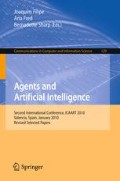Abstract
Many pedestrian simulation models for micro-scale spaces as building indoor areas have been proposed for the last decade and two models – social force model and floor field model – are getting attention. Among these, the CA-based floor field model is viewed more favorable for computer simulations than computationally complex social force model. However, previous floor field-based models have limitations in capturing the differences in dynamic values of different agents. In this study, we improved the floor field model in order for an agent to be able to exclude the influences of its own dynamic values by changing the data structure, and, also modified the initial dynamic value problem in order to fit more realistic environment. As the simulation data structure, we also proposed using a DBMS-based 3D modeling approach. In the simulations, we used real 3D building data stored in a spatial DBMS considering future integration with indoor localization sensors and real time applications. We illustrated the data construction processes and simulations using the proposed enhanced algorithms and DBMS approach.
Access this chapter
Tax calculation will be finalised at checkout
Purchases are for personal use only
Preview
Unable to display preview. Download preview PDF.
References
Arens, C.A.: Maintaining reality: modelling 3D spatial objects in a GeoDBMS using a 3D primitive. M.Sc. Thesis, Delft University of Technology, The Netherlands (2003)
Blue, V.J., Adler, J.L.: Using cellular automata microsimulation to model pedestrian movements. In: Ceder, A. (ed.) Proceedings of the 14th International Symposium on Transportation and Traffic Theory, Jerusalem, Israel, pp. 235–254 (1999)
Bonabeau, E., Dorigo, M., Theraulaz, G.: Swarm intelligence: From natural to artificial systems. Oxford University Press, New York (1999)
Burstedde, C., Klauck, K., Schadschneider, A., Zittartz, J.: Simulation of pedestrian dynamics using a two-dimensional cellular automaton. Physica A 295, 507–525 (2001)
Colin, M., White, T.: Agent-Based Modelling of Force in Crowds. In: Davidsson, P., Logan, B., Takadama, K. (eds.) MABS 2004. LNCS (LNAI), vol. 3415, pp. 173–184. Springer, Heidelberg (2005)
Hamacher, H.W., Tjandra, S.A.: Mathematical modelling of evacuation problems- a state of art. In: Schreckenberg, M., Sharma, S. (eds.) Pedestrian and Evacuation Dynamics, pp. 227–266. Springer, Berlin (2001)
Helbing, D., Farkas, I., Molnár, P., Vicsek, T.: Simulation of pedestrian crowds in normal and evacuation situations. In: Schreckenberg, M., Sharma, S. (eds.) Pedestrian and Evacuation Dynamics, pp. 21–58. Springer, Berlin (2001)
Helbing, D., Molnár, P.: Self-organization phenomena in pedestrian crowds. In: Schweitzer, F. (ed.) Self-Organisation of Complex Structures: From Individual to Collective Dynamics. Gordon & Beach, London (1997)
Henein, C., White, T.: Agent-based modelling of forces in crowds. In: Davidsson, P., Logan, B., Takadama, K. (eds.) MABS 2004. LNCS (LNAI), vol. 3415, pp. 173–184. Springer, Heidelberg (2005)
Henein, C., White, T.: Macroscopic effects of microscopic forces between agents in crowd models. Physica A 373, 694–712 (2007)
Kirchner, A., Schadschneider, A.: Simulation of evacuation processes using a bionicsinspired cellular automaton model for pedestrian dynamics. Physica A 312, 260–276 (2002)
Klupfel, H., Konig, T., Wahle, J., Schreckenberg, M.: Microscopic simulation of evacuation processes on passenger ships. In: Proceedings of Fourth International Conference on Cellular Automata for Research and Industry, Karlsruhe, Germany (October 2002)
Kolbe, T.H.: Representing and exchanging 3D city models with CityGML. In: Lee, J., Zlatanova, S. (eds.) 3D Geo-information Sciences, pp. 15–31. Springer, Berlin (2008)
Nishinari, K., Kirchner, A., Namazi, A., Schadschneider, A.: Simulations of evacuation by an extended floor field CA model. In: Traffic and Granular Flow 2003, pp. 405–410. Spinger, Berlin (2005)
Park, I., Kim, H., Jun, C.: 2D-3D Hybrid Data Modeling for Fire Evacuation Simulation. In: ESRI International User Conference 2007, San Diego (2007), http://gis.esri.com/library/userconf/proc07/papers/papers/pap_1731.pdf
Schadschneider, A.: Cellular automaton approach to pedestrian dynamics - Theory. In: Schreckenberg, M., Sharma, S. (eds.) Pedestrian and Evacuation Dynamics, pp. 75–86. Springer, Berlin (2001)
Stadler, A., Kolbe, T.H.: Spatio-semantic coherence in the integration of 3D city models. In: Proceedings of 5th International ISPRS Symposium on Spatial Data Quality ISSDQ 2007 in Enschede (2007)
Stoter, J.E., van Oosterom, P.J.M.: Incorporating 3D geo-objects into a 2D geo-DBMS. In: ACSM-ASPRS 2002 (2002)
Stoter, J.E., Zlatanova, S.: Visualising and editing of 3D objects organised in a DBMS. In: Proceedings EUROSDR Workshop: Rendering and Visualisation, pp. 14–29 (2003)
Wooldridge, M.: An Introduction to MultiAgent Systems. John Wiley & Sons, Chichester (2002)
Zlatanova, S.: 3D GIS for urban development, PhD thesis, Institute for Computer Graphics and Vision, Graz University of Technology, Austria, ITC, the Netherlands (2000)
Author information
Authors and Affiliations
Editor information
Editors and Affiliations
Rights and permissions
Copyright information
© 2011 Springer-Verlag Berlin Heidelberg
About this paper
Cite this paper
Jun, C., Kim, H. (2011). A 3D Indoor Pedestrian Simulator Using an Enhanced Floor Field Model. In: Filipe, J., Fred, A., Sharp, B. (eds) Agents and Artificial Intelligence. ICAART 2010. Communications in Computer and Information Science, vol 129. Springer, Berlin, Heidelberg. https://doi.org/10.1007/978-3-642-19890-8_10
Download citation
DOI: https://doi.org/10.1007/978-3-642-19890-8_10
Publisher Name: Springer, Berlin, Heidelberg
Print ISBN: 978-3-642-19889-2
Online ISBN: 978-3-642-19890-8
eBook Packages: Computer ScienceComputer Science (R0)

